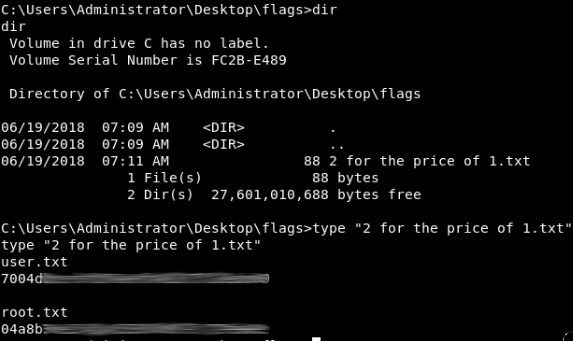HackTheBox Writeup - Jerry
Jerry is one of the easiest boxes in HTB.
Access is obtained thanks to an Apache Tomcat service with default credentials (admin:admin) on port 8080. From there, it's pretty straightforward to get a shell: msfvenom to generate a .war file containing a remote shell connection back, uploading it to server from dashboard, accessing it from the browser and setting up an nc listener to receive the connection. Finally, in the Administrator's desktop, a file contains the two flags that were the initial goal.
Let's continue with a more detailed explanation.
Attack Narrative
Port Scan
As always, I start with an initial scan of top 20 ports using nmap. This allows me to analyze quick results, and start with manual enumeration, while waiting for a full TCP and UDP scan.

Only one port seems to be open:
- Port 8080, http, running Apache Tomcat /Coyote JSP engine 1.1. Apache Tomcat/7.0.88
Meanwhile, a full scan of all 65535 ports gives me the same result:

Vulnerability Analysis
First thing I do is open in the browser port 8080 and check what's there:

The next step I always do when I find a service that requires authentication, is to check for common or default credentials. This time, I got lucky: I can log in using admin:admin as username and password. It's not always that easy, but more times that we can imagine, developers leave default credentials and don't bother to change them. It's always worth to check this first.

Exploitation
Once logged in and knowing the OS name (Windows Server 2012 R2), I can create a .war file containing a reverse shell. I use msfvenom for this:

This file needs to be uploaded from the dashboard, so that's the next step. I go to the Tomcat Manager, find the section WAR file to deploy and upload it.

And then, I click Deploy. Once done, I can see it listed in the applications installed:

If I click on /shell link, it'll redirect me to the page where it deployed my .war file. Once it does this, it will execute a reverse shell to port 4444 and will try to connect to my machine. I set up an nc listener for this, on port 4444.

And then click on /shell to execute the .war code.

I\'ve got a shell!
I can now execute commands on the remote machine. And in this case, the service is running as Administrator, so I can simply navigate to the Administrator's Desktop folder and find my two flags:

Conclusion
Jerry was a fun box, and ideal for beginners. It involves a simple but effective attack that can be found in real assessments like a service running with default credentials and as Administrator. The use of msfvenom is also a good introduction to the tool.
If you get this far, thanks for reading and keep hacking!